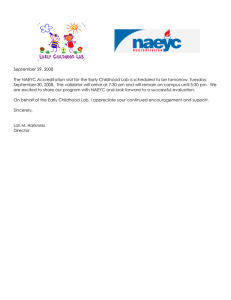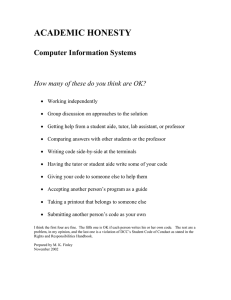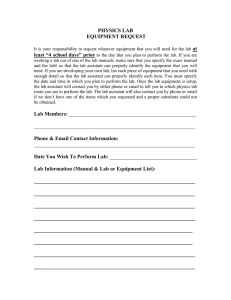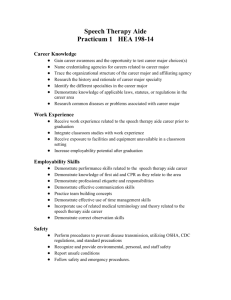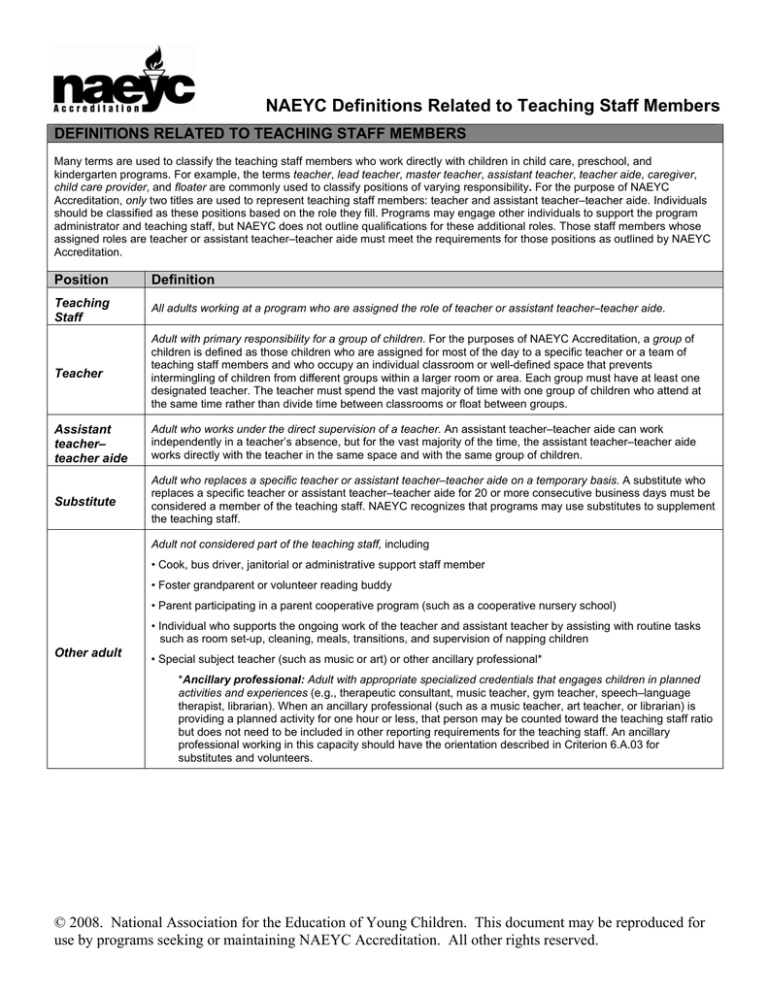
NAEYC Definitions Related to Teaching Staff Members
DEFINITIONS RELATED TO TEACHING STAFF MEMBERS
Many terms are used to classify the teaching staff members who work directly with children in child care, preschool, and
kindergarten programs. For example, the terms teacher, lead teacher, master teacher, assistant teacher, teacher aide, caregiver,
child care provider, and floater are commonly used to classify positions of varying responsibility. For the purpose of NAEYC
Accreditation, only two titles are used to represent teaching staff members: teacher and assistant teacher–teacher aide. Individuals
should be classified as these positions based on the role they fill. Programs may engage other individuals to support the program
administrator and teaching staff, but NAEYC does not outline qualifications for these additional roles. Those staff members whose
assigned roles are teacher or assistant teacher–teacher aide must meet the requirements for those positions as outlined by NAEYC
Accreditation.
Position
Definition
Teaching
Staff
All adults working at a program who are assigned the role of teacher or assistant teacher–teacher aide.
Teacher
Adult with primary responsibility for a group of children. For the purposes of NAEYC Accreditation, a group of
children is defined as those children who are assigned for most of the day to a specific teacher or a team of
teaching staff members and who occupy an individual classroom or well-defined space that prevents
intermingling of children from different groups within a larger room or area. Each group must have at least one
designated teacher. The teacher must spend the vast majority of time with one group of children who attend at
the same time rather than divide time between classrooms or float between groups.
Assistant
teacher–
teacher aide
Adult who works under the direct supervision of a teacher. An assistant teacher–teacher aide can work
independently in a teacher’s absence, but for the vast majority of the time, the assistant teacher–teacher aide
works directly with the teacher in the same space and with the same group of children.
Substitute
Adult who replaces a specific teacher or assistant teacher–teacher aide on a temporary basis. A substitute who
replaces a specific teacher or assistant teacher–teacher aide for 20 or more consecutive business days must be
considered a member of the teaching staff. NAEYC recognizes that programs may use substitutes to supplement
the teaching staff.
Adult not considered part of the teaching staff, including
• Cook, bus driver, janitorial or administrative support staff member
• Foster grandparent or volunteer reading buddy
• Parent participating in a parent cooperative program (such as a cooperative nursery school)
• Individual who supports the ongoing work of the teacher and assistant teacher by assisting with routine tasks
such as room set-up, cleaning, meals, transitions, and supervision of napping children
Other adult
• Special subject teacher (such as music or art) or other ancillary professional*
*Ancillary professional: Adult with appropriate specialized credentials that engages children in planned
activities and experiences (e.g., therapeutic consultant, music teacher, gym teacher, speech–language
therapist, librarian). When an ancillary professional (such as a music teacher, art teacher, or librarian) is
providing a planned activity for one hour or less, that person may be counted toward the teaching staff ratio
but does not need to be included in other reporting requirements for the teaching staff. An ancillary
professional working in this capacity should have the orientation described in Criterion 6.A.03 for
substitutes and volunteers.
© 2008. National Association for the Education of Young Children. This document may be reproduced for
use by programs seeking or maintaining NAEYC Accreditation. All other rights reserved.

